|
|
Isinglass

|
|
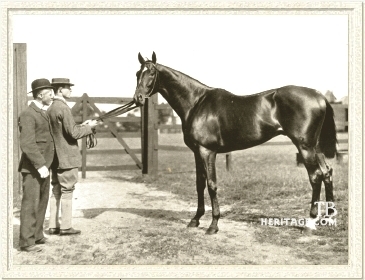 |
|
|
Isinglass was a Triple Crown champion in the 1890s, a decade which saw some of the greatest horses of the Victorian era -- Common, Galtee More, and Flying Fox, all winners of the Triple Crown, as well as Orme, La Fleche, St. Frusquin, and Persimmon.
Isinglass was sired by Isonomy, the mighty Cup performer of the 1870s. Isonomy was a small, compact son of the good middle distance performer and sire, Sterling, and the Stockwell mare Isola Bella, whose dam had captured the Manchester Cup. Sterling sired four classic champions, but Isonomy was his best performer, winning the Goodwood Cup, Ascot Gold Cup, and Doncaster Cup in the same season, a feat that would not accomplished again for seventy years. Isonomy proved himself to be a fine sire, but was always in the shadow of more glamorous stallions, Hermit and St. Simon, who dominated the British sire list during the last two decades of the nineteenth century. Still, Isonomy sired three classic winners, and two of them--Isinglass and Common--captured the Triple Crown, at the time an unprecedented feat.
Isinglass was foaled in 1890, and it could be argued that his pedigree was less regal than that of Isonomy's two other classic winners: Seabreeze, who was out of the fine producing Hermit mare St. Marguerite and Common, who was out of the Scottish Chief mare Thistle, later the dam of major winners Goldfinch and Throstle. Isinglass was out of Dead Lock, by Wenlock. The sire line of Dead Lock consisted of an unbroken chain of St. Leger winners--Wenlock, Lord Clifden, Newminster, and Touchstone. However, Wenlock had not been a great success at stud, his principal claim to fame was as broodmare sire of the 1890 Derby winner Sainfoin.
Prior to Isinglass, Dead Lock had produced seven foals, including another Isonomy colt named Islington, and a Trappist colt named Gervas. Both were stakes winners, but not of the highest class. Her female family had been quiet for several generations. One had to go back to the seventh dam of Dead Lock, a mare named Fractious, who had produced 1804 Derby winner Hannibal and his full sister Amazon, Dead Lock's sixth dam. There were two different tales concerning the unraced Dead Lock, who had been culled as a yearling by her breeder, Lord Alington as a yearling; one claimed she had been used as a driving mare or cart horse, and another as a hack. She died in 1893.
Isinglass was bred by Harry (later Colonel) McCalmont. During his racing career, Isinglass proved himself to be the best of an extraordinary crop of high-bred colts, for also foaled that year were Ravensbury and Raeburn. Ravensbury, like Isinglass, was a son of Isonomy. His dam was a full sister to dual classic winning filly Shotover. Raeburn, a son of St. Simon, was bred by the Duke of Portland, and was the third good runner from the Duke's excellent mare Mowerina, dam previously of the classic winners Donovan and Semolina.
Isinglass was big, strongly made colt with weak-looking forelegs. His personality exhibited an extreme streak of laziness, for Isinglass would not overly exert himself in either his works or his races. Despite this character flaw, Isinglass was a gentle horse. The racing career of Isinglass was managed by Captain James Machell for McCalmont, and he was trained at Newmarket by James Jewitt, who had also trained his sire Isonomy.
Isinglass on the Turf
Isinglass was out three times at age two and won all three: a maiden plate, the New Stakes at Ascot, and the Middle Park Plate at Newmarket. In the New Stakes, Isinglass met Ravensbury for the first time and beat him into third place. In the Middle Park Plate, both colts carried 129 pounds and Isinglass prevailed by a length and a half. Raeburn was also in this race, but ran unplaced.
Isinglass was a horse which disliked firm going, and as the classics approached, the ground was unusually hard. Trainer Jewitt was of a mind to withdraw Isinglass from the first of the classic races, the Two Thousand Guineas, and await the Derby, but he was overruled by Captain Machell, who ordered the horse trained over tanbark.
In the Guineas, jockey Tommy Loates, small even for a jockey, had all he could do to drive the indolent Isinglass to a three-quarter length win over Ravensbury. Raeburn finished four lengths further back in third place.
A fortnight later, Isinglass took the Newmarket Stakes from Phocion, with Ravensbury third. This 1-1/4 mile contest set Isinglass up perfectly for the 1-1/2 mile Derby Stakes at Epsom, the last Wednesday in May. The race mirrored the Two Thousand Guineas, as Isinglass won by a length and a half over Ravensbury, with Raeburn a further two lengths back in third place.
Isinglass was rested until the fall meeting at Doncaster and the St. Leger. The summer off did not dull the form of either Isinglass or Ravensbury, and once again they finished one-two, Isinglass the victor by half a length. Isinglass thus added his name to an illustrious list of Triple Crown champions, which to that time included West Australian, Gladiateur, Lord Lyon, Ormonde, and Common. Poor Ravensbury proved he would have been a great horse were it not his ill fortune to have been foaled in the same year as Isinglass.
The aura of invincibility which surrounded Isinglass was diminished somewhat in his next start, the Lancashire Plate. In this race, Isinglass suffered the only defeat of his career. Against a stellar field which included the previous year's multiple classic-winning filly La Fleche, Isinglass finished second. The race was run at a flat mile, which was not the favorite distance of the Triple Crown champion, he was asked to concede ten pounds to Raeburn, and make all the running. The combination of circumstances proved too much, and Isinglass went under to Raeburn by a length, with La Fleche just half a length behind Isinglass in third place. Thus Raeburn, who was a notch below Isinglass and Ravensbury in form, nevertheless accomplished something no other horse had done, nor would not do again--defeat Isinglass.
As a four-year-old, Isinglass raced only three times, his targets the prestigious trio of 1-1/4 mile races made up of the Princess of Wales' Stakes, the Eclipse Stakes, and the Jockey Club Stakes. As had been the case the previous season, the weather was dry, leaving the ground very hard. In addition, Isinglass had developed an annoying tendency to eat his bedding, as well as his own droppings, which upset his digestion. When he was ready to make his four-year-old debut, it came in early July. For the Princess of Wales' Stakes, Isinglass was asked to shoulder a staggering 143 pounds against that season's Two Thousand Guineas and Derby winner Ladas, the St. Simon colt St. Florian, and old foes Ravensbury and Raeburn. Isinglass narrowly avoided a second straight defeat, winning by a head from Bullingdon. Ladas was third, Ravensbury and Raeburn unplaced.
On softer ground at Sandown Park for the Eclipse Stakes, Isinglass was back to his masterful self. Ladened with 142 pounds, Isinglass again took the measure of Ladas, who finished second by a length, with Ravensbury three lengths farther back in third, Raeburn unplaced.
The final start of the season for Isinglass came at Newmarket in the Jockey Club Stakes. Isinglass was once again weighted at 142 pounds, and once again prevailed, this time by two lengths over the high class French colt Gouvernail. Raeburn ran unplaced, as did that season's St. Leger winner, Throstle.
Isinglass had only one start as a five-year-old, and that was for the Ascot Gold Cup. It was the easiest victory of his career. He won by three lengths from the good handicap performer Reminder.
Isinglass retired with eleven victories from twelve lifetime starts and £58,655 in prize money, at the time the most purse money ever won. He had proven his superiority over and over again. Isinglass met the luckless Ravensbury eight times, and defeated that rival on each occasion. Isinglass met Raeburn seven times, and won six of those meetings. The lovely Hampton colt Ladas opposed Isinglass twice and was vanquished both times. Isinglass met the brilliant mare La Fleche once and finished ahead of her.
Isinglass in the Stud
McCalmont retired his champion to Cheveley Park Stud near Newmarket, where he held court at a fee of 200 guineas. During his stud career, Isinglass proved somewhat of a disappointment, in that he failed to sire a Derby winner, but he did get three classic winners, plus two sons who went on to become very influential stallions.
|
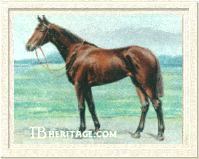
Cherry Lass
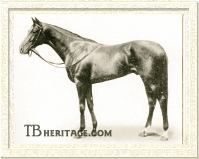
Louvois
| |
CHERRY LASS (1902), the first of her sire's three classic winners, was bred and owned by Col. William Hall Walker (later Lord Wavertree) and trained by W.T. Robinson. Her dam was Black Cherry, by Bendigo out of Bay Ronald's dam Black Duchess. During her career, Cherry Lass won ten races. She captured the Anglesey Stakes at The Curragh in Ireland, the Free Handicap at Newmarket, the One Thousand Guineas, the Oaks, the St. James's Palace Stakes, and the Nassau Stakes. She also finished a gallant third to Challacombe and Polymelus in the St. Leger.
Sadly, she did not make a successful broodmare, as she had only two recorded foals, a colt by Gallinule and a filly by Robert le Diable. However, her younger half-sister, the unraced White Eagle filly Blanche, made up for the disappointing stud career of her sibling by becoming the dam of three-time leading British sire Blandford.
GLASS DOLL (1904), out of the Hampton mare Fota, raced for Jack Joel. She was not anywhere close to the racing class of Cherry Lass, for the only other race she won besides the 1907 Oaks Stakes was a small nursery at Nottingham. She, too, failed to make a mark as a broodmare, though she was the third dam of Advocate, a prominent stallion in Argentina, and she was the fourth dam of My Bonnie, a classic winner in New Zealand.
|
LOUVOIS (1910), out of St. Louvaine, by Carnage or Wolf's Crag, captured the Boscawen Stakes and the Dewhurst Plate at two, and the Two Thousand Guineas and Prince of Wales's Stakes at three. He was also second in the sensational Derby of 1913, where C. Bower Ismay's Desmond colt Craganour was disqualified for interference, the race awarded to another son of Desmond named Aboyeur. Louvois placed second to Tracery in the Eclipse Stakes and third to Craganour and Sun Yat in the Newmarket Stakes.
At stud, Louvois sired St. Louis, a winner of the Two Thousand Guineas, and the fine producer Harpsichord. This granddaughter of Isinglass became the dam of Royal Minstrel, Coventry Stakes and Dewhurst Plate winner Hairan, and Qurrat-al-Ain, dam of dual Irish classic-winning filly Majideh and second dam of American classic winner Gallant Man.
Two important sons of Isinglass who failed in their bids to become classic winners were JOHN O' GAUNT and LOUVIERS (1906), a full brother to Louvois. Louviers proved to be nearly as talented as his brother, for he won the Coventry Stakes and the Newmarket Stakes, and just missed winning the Derby, losing by just a head to King Edward VII's Minoru.
|
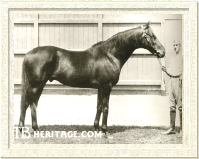
Louviers
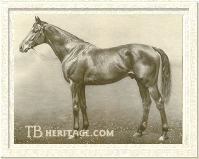
John o' Gaunt
| |
As a stallion, Louviers was most notable as the sire of Landgraf, a winner of the Deutsches Derby. The male line of Isinglass via Louviers survived in Germany for several generations through Landgraf and his descendants, as he sired two winners of the Deutsches Derby--Hausfreund and Ferro. The latter sired two winners of the race, one of those being Athanasius, sire of another Deutsches Derby winner in Ticino, sire of a further four winners of the race and Germany's leading sire from 1950 through 1958. The line continued starting in 1959 with Ticino's son Neckar who led the German sire list in 1959 and 1960 and again from 1962 through 1965. Another Ticino son, Orsini, led four times, and Kronzeuge, a son of Neckar, led once.
In 1900, Isinglass met the great mare La Fleche for a second time, this time in the breeding shed at Sledmere Stud. The following spring of 1901, she dropped a bay colt later named JOHN O' GAUNT. As a yearling, despite his bad forelegs, John o' Gaunt brought a final bid of 3000 guineas from Sir John Thursby. His racing record could be described as mediocre at first glance, for he won just once in seven starts at two and three. However, John o' Gaunt was trained throughout his career by American trainer William Duke, a man known for his unscrupulous training methods, including doping. |
There is no proof that Duke ever doped John o' Gaunt, but he did allow the colt's owner to let his half-brother, George Thursby, ride the horse in several of his races as an amateur. Under these circumstances, John o' Gaunt finished a creditable second to St. Amant in the Two Thousand Guineas, second by a head to Henry the First in the Newmarket Stakes, and second again to St. Amant in the Derby, his last racecourse appearance. That the colt had talent was undeniable, but he never enjoyed the services of a top class trainer or jockey.
As a stallion, John o' Gaunt came up with St. Leger winner and major sire Swynford, later the sire in turn of Blandford; Tootles, second in the Oaks; Kennymore, winner of the Two Thousand Guineas; and Burne Jones, winner in Italy of the Gran Premio di Milano, the St. Leger Italiano, and the Premio Parioli. John o' Gaunt's daughter, Mandy Hamilton, was exported to the United States and became the dam of major American sire Supremus as well as Hollyrood, a good American stakes winner of the mid-1930s. John o' Gaunt was put down in 1924, a year after his son Swynford led the British sire list. |
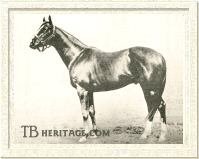
Starshoot
| |
The male line of Isinglass received a major boost in America through the siring prowess of his son STAR SHOOT (1898). Bred by Major Eustace Loder at Eyrefield Lodge Stud in Ireland, Star Shoot was a chestnut colt out of Astrology, by Hermit. Star Shoot was a good two-year-old, winning three of his eight starts, including the British Dominion Two-Year-Old Plate, the Hurst Park Foal Plate, and dead-heated for victory with Bay Melton in the National Breeders Produce Plate. In the Champion Breeders Biennial Foal Stakes, Star Shoot was defeated by an Isinglass filly named SAGITTA, a full sister to John o' Gaunt. |
Star Shoot developed breathing problems as a three-year-old, and started only twice, suffering defeat both times. Thus ended prematurely a racing career which had flashed strong promise only the season previous. Because the British were none too keen on horses with wind infirmities as breeding prospects, Star Shoot was sold, and wound up at the Runnymede Farm of Catesby Woodford near Paris, Kentucky. Star Shoot stood there from 1902 until 1912, when he was sold to John Madden and sent to stand at Madden's Hamburg Place near Lexington, and there he remained until his death in 1919.
Star Shoot became one of the most dominant American stallions of his era. The son of Isinglass led the American sire list in 1911, 1912, 1916, 1917, and 1919, and was in the top three on six other occasions. His progeny included American Triple Crown winner Sir Barton, champion Grey Lag, major sire Uncle, Suburban Handicap winner Audacious, and Gazelle Stakes winner Fairy Wand. Daughters of Star Shoot produced champion Crusader, Travers Stakes winner Mars, champion filly Careful, classic-placed Escoba, Jack High, classic-placed colt Genie, and Coaching Club American Oaks victress Wistful. Astrology also bred a sister to Starshoot, L'Etoile, dam of Ecouen (1910), who won some good races in France, including the Grand Criterium, Prix Lupin and Prix Daru and later was broodmare sire of the U.S. champion filly Bateau.
KILGLAS (1900), out of the Ormonde mare Kilkenny, was a superbly bred individual -- by a Triple Crown champion out of a daughter of another. As is so often the case, such royally bred horses fail to live up to the extraordinary promise of such parentage. At stud, Kilglas sired Grignouse, dam of La Grelee, by Helicon. This filly became the dam of French stakes winners Rialto, Roahouga, and Alcyon, and ancestress of French classic-winning filly Tahiti, Lancastrian, Teleprompter, Brazilian runner Noquinha, and Australian standout Kingston Town. |
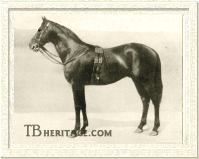
Rising Glass
| |
Isinglass sired some noteworthy runners which placed in the classics or major stakes. Among these were; ADMIRABLE CRICHTON (1903), out of the dam of Pretty Polly, who won the Chesterfield Stakes and the Rous Memorial Stakes as a juvenile, and Doncaster's Cleveland Handicap at age three; BALTINGLASS, out of Sibola, by The Sailor Prince, placed second in the St. Leger and third in the Dewhurst Stakes; COURTESY (1905), out of Cortegar, by Galliard, placed second in the Oaks; BELLEISLE, out of Virginal, by Ladas, won the Cheveley Park Stakes and placed third in both the One Thousand Guineas and Park Hill Stakes; and GLASS JUG (1899), out of Amphora, by Amphion, ran second in the Oaks.
|
RISING GLASS (1899), out of Hautesse, by Archduc, had the misfortune to be a contemporary of as Sceptre and Ard Patrick. Rising Glass ran second to Ard Patrick in the Derby, and second to Sceptre in the St. Leger. He was also second to Maximum II in the Ascot Gold Cup.
Isinglass as a Broodmare Sire
Isinglass enjoyed tremendous success as a sire of broodmares, and it could be argued he was more influential in that aspect of his breeding career, for many of the descendants of his daughters are still making an impact on the breed today.
|
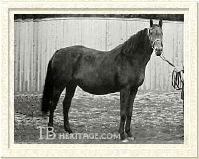
Lady Lightfoot, dam of Prince Palatine
| |
LADY LIGHTFOOT (1900) was a result of the union of Isinglass with the Ayrshire mare Glare. Lady Lightfoot was a half sister to One Thousand Guineas winner Flair and to Coronation Stakes winner Lesbia. Despite her noble pedigree, Lady Lightfoot was not a successful performer on the racetrack, wining some minor events and also being tried over hurdles with limited success. But as a broodmare for Col. Hall Walker, she produced a colt which Colonel Walker firmly believed to be the finest horse he ever bred, the Persimmon colt Prince Palatine.
|
During his racing career, Prince Palatine won the St. Leger, the Coronation Cup, the Jockey Club Stakes, and two runnings of the Ascot Gold Cup. His career as a stallion was chequered, as he was tried in England, France, and finally the United States, where he died at the age of sixteen in a barn fire at Xalapa Stud near Paris, Kentucky. Initially condemned as a failure, in the long run, this grandson of Isinglass proved tremendously influential, as a short list of his descendants will attest: Prince Rose, Princequillo, Prince Bio, Prince Chevalier, Prince John, and Round Table from his direct male line, and Vagrancy, Top Flight, Unbreakable, Boudoir II, His Majesty, Graustark and others which were descended from his daughters.
GLASALT (1898), out of the Hampton mare Broad Corrie, was an Isinglass daughter who founded a powerful family for the stud of the Earl of Derby. As a juvenile she won the Ham Stakes at Goodwood and Newmarket's Buckenham Stakes. Her daughter Canyon, by Chaucer, captured the One Thousand Guineas and went on to become the dam of Eclipse Stakes winner Caerleon and Two Thousand Guineas winner Colorado. Another daughter of Glasalt, the St. Simon filly Glacier, became the dam of Oaks heroine Toboggan, and she in turn, became the dam of sire Bobsleigh and of Hydroplane II. The latter, a daughter of Hyperion, was purchased by Calumet Farm and sent to the storied Lexington, Kentucky nursery during World War II. There she became the dam of American Triple Crown champion Citation. Glasalt also produced Dewhurst Plate winner King William and stakes winners Glacis and Queen's Journal.
GOODY TWO SHOES (1899) won the Suburban Plate at Cork Park in Ireland at age three, and ran second in the Irish Oaks. Out of the Kisber mare Sandal, she foaled two important horses: son Charles O'Malley and daughter Simon's Shoes. The former became broodmare sire of English classic winner Blenheim II (in-bred 4 x 4 to Isinglass), and the latter became the second dam of the extraordinary producer Rough Shod, ancestress of Gamely, Moccasin, Nantallah, Drumtop, Ridan, Lt. Stevens, Special, Nureyev, Fairy King, and Sadler's Wells. Simon's Shoes also had a daughter named Carpet Slipper, who became the dam of Irish Triple Crown winner Windsor Slipper.
The unraced BRIDGE OF SIGHS (1905), out of the St. Simon mare Santa Brigida, produced the Picton colt Light Brigade. Not entered for the classics, Light Brigade nevertheless won eleven straight races as a three-year-old, his most important victories coming in the Great Yorkshire Stakes and the Duke of York Stakes. Exported for stud duty to the United States, he became a decent sire, coming up with Kentucky Oaks heroine Rose of Sharon, Preakness Stakes winner Dr. Freeland, Crack Brigade, Fair Phantom, and Ariadne, dam of champion and major sire Discovery.
Isinglass was the sire of another filly out of Santa Brigida named ST. CLAIRE II (1904). Undistinguished as a runner (winner of one race of seven, the Knowsley Dinner Stakes, at age three), her importance lies in her daughter -- the unraced Cicero filly Lady Cicero. Bred to Roi Herode, Lady Cicero became the dam of Regal Roman. This mare was sold to the Headley family's Beaumont Farm near Lexington, Kentucky, and there foaled champion filly Alcibiades, dam of the sire Menow and fourth dam of champion and important sire Sir Ivor.
When Isinglass was mated to Chelandry, the resultant foal was a filly named SAMPHIRE (1924). Unplaced on the racetrack, she nevertheless was coveted as a broodmare prospect due to the fact she was a member of the prolific Paraffin family. She produced, to the cover of Robert le Diable, the good colt Wrack, who after his exportation to Kentucky for stud duty, became a successful stallion. Jiffy, a granddaughter of Samphire, produced Epsom Derby winner Ocean Swell.
CORNFIELD (1904), out of Landrail, by St. Serf, won the St. George Stakes at Liverpool at age three, and ran second three times, including the Doncaster Stakes. She became the dam of Love In Idleness, winner of the Oaks and the Park Hill Stakes, later dam of the good Australian sire Gay Lothario who became sire of the tough mare Tranquil Star.
A union of Isinglass with the great racemare Sceptre yielded the filly CORONATION IV (1908). A disappointment on the racecourse, with just a third in the Cheveley Park Stakes to her resume, she was purchased by Federico Tesio for his broodmare band in Italy. Unable to produce anything of significant merit for Tesio, she was returned to England. But a daughter foaled in Italy, Terra d'Ombra, later became the dam of Crepescule, ancestress of such important names as Northern Light, Midnight Sun, Relance, Match II, Relko, and Reliance II.
VAIN DUCHESS (1897), out of Sweet Duchess, by Hagioscope, won four races, including Doncaster's Rous Stakes as a juvenile, and became the dam of Helicon. Sired by Cyllene, which gave Helicon 3x3 inbreeding to Isonomy, he sired the aforementioned mare La Grelee as well as Helene de Troie, dam of the three-quarter sisters Adargatis and La Troienne.
LYGIE (1900), out of Derby winner Silvio's daughter, Livie, ran second in France's 1,000 Guineas andin the Prix Semendria. Through her daughter Medeah, Lyvie became third dam of La Flambette, fifth dam of American Triple Crown winner Omaha and dual American classic winner Johnstown, and American champion mare Gallorette. Kentucky Derby winner Decidedly was also a descendant of Lygie.
The unraced ABBAZIA (1908), out of St. Simon's classic-winning daughter Mrs. Butterwick, became the dam of a filly by The Tetrarch named Tetrabazzia, who gained distinction as the dam of St. Leger winner Singapore, by Gainsborough; MALATESTA (1898), out of Parisina, by St. Simon, became the dam of La Farina, winner of the Prix Lupin and later an influential French sire; MRS. DESPARD (1905), out of Cri de Guerre, by McMahon, became the dam of Poule d'Essai des Poulains (French 1,000 Guineas) winner McKinley and of Derby Roman winner Zori-de-Zi.
CONFECTION (1909), an undistinguished race filly out of Miramar, by Martagon, became the dam of the Rabelais colt Pendennis, winner of the classic Poule d'Essai des Poulains. She was also the fourth dam of two-time Prix de la Foret champion Fine Top.
Isinglass lived to the age of 21. He died at Cheveley Park Stud on December 5, 1911. Like his sire, Isonomy, Isinglass never led the British sire list. He came close in 1905, when he was the leading sire in England, but the overall title went to another son of Isonomy, Gallinule. The leading British sire of 1904, Gallinule landed the honor again in 1905 when the earnings of his Irish runners were factored into the equation. Isinglass did lead the broodmare sire list once, posthumously in 1912. Isinglass remains the only horse to win the Triple Crown, the Ascot Gold Cup and the Eclipse Stakes. Today, the skeleton of Isinglass is on display at the Natural History Museum, London, along with those of fellow champions St. Simon, Ayrshire, Persimmon, and Brown Jack.
-- Liz Martiniak
|
|
|
|

